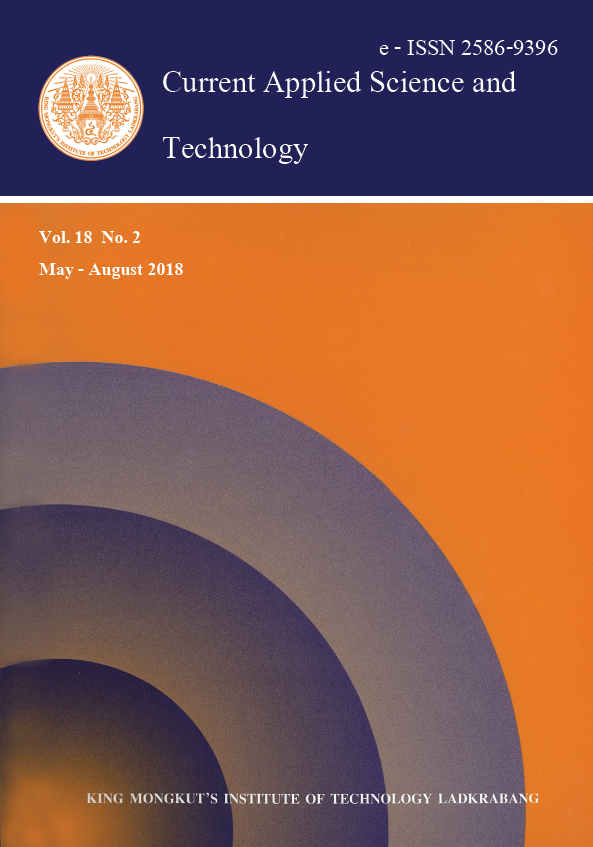Antioxidant and Antihyperglycemic Activities of Four Edible Lentinus Mushrooms
Main Article Content
Abstract
Four Lentinus mushrooms: Lentinus edodes, Lentinus polychrous, Lentinus sajor-caju, and Lentinus squarrosulus were investigated for their chemical compositions as well as their antioxidants and hyperglycemic activities. The chemical composition of Lentinus mushrooms contained total phenolic and total flavonoid contents, normally used as an indirect measurement of antioxidant capacity. Scavenging activity on DPPH radicals and FRAP assays were used for confirming antioxidant activity while assays of α-glucosidase inhibitory activity were used for evaluating antihyperglycemic activity in these mushroom extracts. The highest amount of total phenolic content (TPC) displayed in the extract of L. squarrosulus which correlated well with antioxidant properties of mushroom extracts indicated by DPPP and FRAP assays. It is firstly reported herein on α-glucosidase inhibitory activity in Lentinus mushrooms, in which L. polychrous revealed the highest inhibitory activity (IC50 value 39.59±0.01 μg/mL) and correlated well with total flavonoid compound.
Keywords: α-glucosidase inhibitor, Lentinus edodes, Lentinus polychrous, Lentinus sajor-caju L. squarrosulus, antihyperglycemic, antioxidation
*Corresponding author: E-mail: rwimon@aru.ac.th
Article Details
Copyright Transfer Statement
The copyright of this article is transferred to Current Applied Science and Technology journal with effect if and when the article is accepted for publication. The copyright transfer covers the exclusive right to reproduce and distribute the article, including reprints, translations, photographic reproductions, electronic form (offline, online) or any other reproductions of similar nature.
The author warrants that this contribution is original and that he/she has full power to make this grant. The author signs for and accepts responsibility for releasing this material on behalf of any and all co-authors.
Here is the link for download: Copyright transfer form.pdf
References
[2] Ayodele, S.M., and and Idoko, M.E., 2011. Antimicrobial activities of four wild edible mushrooms in Nigeria. International Journal of Science and Nature, 2, 1, 55-59.
[3] Ren, L., Hemar, Y., Perera, C.O., Lewis, G., Krissansen, G.W. and Buchanan, de K,P., 2014. Antibacterial and antioxidant activitis of aqueous extract of eight edible mushrooms, Bioactive Carbohydrates and Dietary Fibre, 3, 41-51.
[4] Attarat, R., and Phermthai, T., 2015. Bioactive compounds in three edible Lentinus mushrooms, Walailak Journal of Science and Technology, 12(6), 491-504.
[5] Sharma, S.K. and Atri, N.S., 2014. Nutraceutical composition of wild species of genus Lentinus Fr. from northern India. Current Research in Environmental&Applied Mycology, 4, 11-32.
[6] Ayodele, S.M. and Idoko, M.E., 2011. Antimicrobial activities of four wild edible mushrooms in Nigeria. International Journal of Science and Nature, 2(1), 55-59.
[7] Ren, L., Hemar, Y., Perera, C.O., Lewis, G., Krissansen, G.W. and Buchanan. de K, P., 2014. Antibacterial and antioxidant activitis of aqueous extract of eight edible mushrooms, Bioactive Carbohydrates and Dietary Fibre, 3, 41-51.
[8] Pegler, D.N., 1983. The genus Lentinus: A new monograph. Kew Bulletin Additional Series X, 10,1, 281, Royal Botany Garden, Kew.
[9] Taga, M.S., Miller, E.E. and Pratt, D.E., 1984. Chai seed as a source of natural lipid antioxidants, Journal of American Oil Chemistry Society, 61, 928-31.
[10] Jeong, H.J., Kim, J. S., Hyun, T.K., Yang, J.F., Kang, H.H., Cho, J.C., Yeom, H.M. and Kim, J.M., 2013. In vitro antioxidant and antidiabetic activities of Rehmannia glutinosa tuberous root extracts, Science Asia, 39, 605-609.
[11] Moreno, M.I., Isla, M.I., Sampietro, A.R. and Vattuone, M.A., 2000. Comparison of the free radical scavenging activity of propolis from several regions of Argentina, Ethnopharmacol, 71, 109-114.
[12] Bloise, M.S., 1958. Antioxidant determination by the use of stable free radicals, Nature,181,1199-2000.
[13] Benzie, I.F.F. and Strain, J.J., 1996. The ferric reducing ability of plasma (FRAP) as a measure of "antioxidant power": the FRAP assay, Analytical Biochemistry, 239, 70-76.
[14] Jeong, H.J., Kim, J. S., Hyun, T.K., Yang, J.F., Kang, H.H., Cho, J.C., Yeom, H.M. and Kim, J.M., 2013. In vitro antioxidant and antidiabetic activities of Rehmannia glutinosa tuberous root extracts, Science Asia, 39, 605-609.
[15] Phuwapraisirisan, P., Puksasook, T., Jong-aramruang, J. and Kokpol, U., 2008. Phenylethyl cinnamides: A new series of α-glucosidase inhibitors from the leaves of Angle marmelos, Bioorganic & Medicinal Chemistry Letters,18, 4956-4958.
[16] Wikul, A., Damsud, T., Kataoka, K. and Phuwapraisirisan, P., 2012. (+)-Pinoresinol is a putative hypoglycemic agent in defatted sesame (Sesamum indicum) seeds though inhibiting α-glucosidase. Bioorganic & Medicinal Chemistry Letters, 22, 5215-5217.
[17] Worawalai, W., Wacharasindhu, S. and Phuwapraisirisan, P., 2012. Synthesis of new Nsubstituted aminoquercitols from naturally available (+)-proto-quercitol and their α-glucosidase inhibitory activity. Medicinal Chemistry Communications, 3, 1466-1470.


